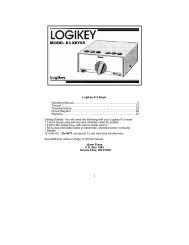4-BTV, 5-BTV, 6-BTV Multiband HF - K6RF Home of the Porta Base ...
4-BTV, 5-BTV, 6-BTV Multiband HF - K6RF Home of the Porta Base ...
4-BTV, 5-BTV, 6-BTV Multiband HF - K6RF Home of the Porta Base ...
You also want an ePaper? Increase the reach of your titles
YUMPU automatically turns print PDFs into web optimized ePapers that Google loves.
Hustler Trap Calibration - Resonance Adjustment Procedure<br />
Tune all Hustler <strong>BTV</strong>s starting with <strong>the</strong> 10 meter trap, because any adjustment done <strong>the</strong>re<br />
affects <strong>the</strong> rest <strong>of</strong> <strong>the</strong> antenna, regardless <strong>of</strong> <strong>the</strong> number <strong>of</strong> bands it has.<br />
1. Slightly loosen <strong>the</strong> band clamp<br />
at <strong>the</strong> bottom <strong>of</strong> <strong>the</strong> trap sleeve,<br />
NOT <strong>the</strong> clamp on <strong>the</strong> larger<br />
tube below.<br />
2. Loosen <strong>the</strong> trap cover.<br />
3. Adjust <strong>the</strong> trap sleeve position<br />
on <strong>the</strong> trap bottom tube. Typical<br />
adjustment is to move <strong>the</strong> trap<br />
sleeve downward on <strong>the</strong> trap<br />
lower tube about 1/4 to 1/2 inch<br />
reducing <strong>the</strong> A2 dimension<br />
below <strong>the</strong> 10 meter trap for a<br />
shift <strong>of</strong> +500 kHz.<br />
4. Firmly tighten <strong>the</strong> band clamp.<br />
5. Reposition <strong>the</strong> trap cover.<br />
6. Raise <strong>the</strong> antenna, re-test to find<br />
<strong>the</strong> new frequency <strong>the</strong> SWR dip.<br />
7. Readjust (repeat steps 1-6) to move <strong>the</strong> SWR dip to <strong>the</strong> desired frequency.<br />
After you adjust one trap, check all bands before repeating steps 1 though 7 for <strong>the</strong> o<strong>the</strong>r traps in<br />
order (15M <strong>the</strong>n 20M <strong>the</strong>n 30M depending on <strong>BTV</strong> model).<br />
It is not necessary and counter-productive to readjust <strong>the</strong> spacing (A2, B2, C2 or D2) to <strong>the</strong> original<br />
chart dimension after a trap sleeve adjustment. In some cases, you may need to increase <strong>the</strong>se<br />
spaces between <strong>the</strong> trap sleeves and <strong>the</strong> antenna sections to allow enough spacing to complete<br />
recalibration.<br />
Note: Like o<strong>the</strong>r antenna adjustments, trap adjustments are not permanent and can be restored<br />
easily. You marked <strong>the</strong> position <strong>of</strong> <strong>the</strong> trap sleeve on <strong>the</strong> trap lower tube before you started, so<br />
returning to <strong>the</strong> starting point will be simple.<br />
Do not worry if you cannot tune <strong>the</strong> antenna to <strong>the</strong> lowest possible SWR <strong>of</strong> 1.0:1 at your frequency<br />
<strong>of</strong> choice. A minimum SWR <strong>of</strong> 1.4:1 to 1.6:1 is acceptable for <strong>HF</strong> operations, representing a minor<br />
RF power reflection <strong>of</strong> only 3 to 5%.<br />
Your new high efficiency antenna system is now properly installed and tuned and will reward you<br />
with years <strong>of</strong> service.<br />
- 42 -



